An open letter to the green revolution
Through this open letter to Shri MS Swaminathan, Bhaskar Save-ji hopes that it “…provokes some soul-searching and open debate at all levels on the extremely vital issues involved – so that we do not repeat the same kind of blunders…”
When I and Deepti decided to go back to the land, we explored possibilities by reading books and meet interesting people. One such exploration in the year 2012 led us to ‘Kalpavruksha’, the natural farm of Late Shri Bhaskar Save (Spelt Sa-way). Bhaskar-ji passed away in 2015 at an age of 93.
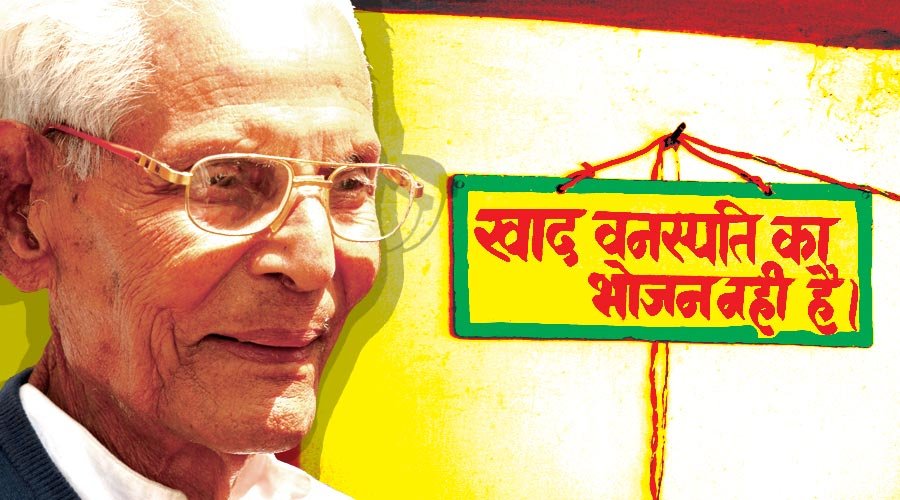
Bhaskar-ji is often referred to as ‘Gandhi of natural farming’. In 2010, the International Federation of Organic Agriculture Movements (IFOAM) honoured him with ‘One World Award for Lifetime Achievement’.
While we were on a guided visit of Bhaskar-ji’s farm, I saw a naturally grown coconut tree loaded with few hundred fruits. I immediately called up some friends in Kerala and asked if they had ever witnessed such numbers. The answer was in negative. When we asked Bhaskar-ji about it, he said that this is possible only when a tree is free to realise its full natural potential, without human intervention which is designed to dictate terms of its growth.
Bhaskar-ji’s thoughts are well summarised in this first open letter that he wrote to Shri MS Swaminathan, then Chairperson of National Commission on Farmers. Shri MS Swaminathan is regarded as the father of ‘Green Revolution’. This letter is the first of the three letters Bhaskar-ji wrote to Shri MS Swaminathan.
For ease of reading, I wanted to summarise this rather long letter but then gave up the idea. I think that if one wants to really understand the issues, then one will have to invest time and energy to read and understand what a farmer is trying to say. 280 characters or ‘inshorts’ are not going to work. And if one cannot invest this much of time then it is advisable to cease getting emotionally invested in the conditions of farmers and farming in India. Opinions without a context do not make much sense and will not be of much help.
In Bhaskar-ji’s own words –
“I hope this provokes some soul-searching and open debate at all levels on the extremely vital issues involved – so that we do not repeat the same kind of blunders that led us to our present, deep festering mess.”
While at the farm, I had clicked some pictures. I am sharing them here to provide a glimpse of the farm as well as visual relief, if needed.
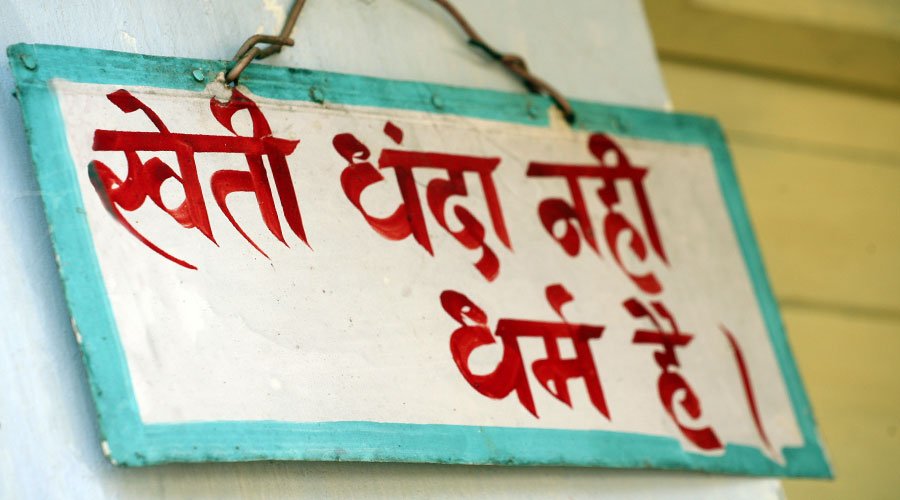
The open letter from Bhaskar Save to MS Swaminathan
From,
Bhaskar Save, ‘Kalpavruksha’ Farm,
Village Dehri, via Umergam, Dist. Valsad (Gujarat)
To,
Shri MS Swaminathan,
The Chairperson, National Commission on Farmers,
Ministry of Agriculture, Govt. of India
July 29, 2006
Subject: Mounting Suicides and National Policy for Farmers
Dear Shri Swaminathan,
I am an 84 year old natural/organic farmer with more than six decades of personal experience in growing a wide range of food crops. I have, over the years, practised several systems of farming, including the chemical method in the fifties – until I soon saw its pitfalls.
I say with conviction that it is only by organic farming in harmony with Nature, that India can sustainably provide her people abundant, wholesome food. And meet every basic need of all – to live in health, dignity and peace.
You, MS Swaminathan, are considered the ‘father’ of India’s so-called ‘Green Revolution’ that flung open the floodgates of toxic ‘agro’ chemicals – ravaging the lands and lives of many millions of Indian farmers over the past 40 years. More than any other individual in our long history, it is you I hold responsible for the tragic condition of our soils and our debt-burdened farmers, driven to suicide in increasing numbers every year.
As destiny would have it, you are presently the chairperson of the ‘National Commission on Farmers’, mandated to draft a new agricultural policy. I urge you to take this opportunity to make amends – for the sake of the children, and those yet to come.
I understand your Commission is inviting the views of farmers for drafting the new policy. As this is an open consultation, I am marking a copy of my letter to the Prime Minister, the Union Minister for Agriculture, the Chairperson of the National Advisory Council, and to the media – for wider communication. I hope this provokes some soul-searching and open debate at all levels on the extremely vital issues involved – so that we do not repeat the same kind of blunders that led us to our present, deep festering mess.
The great literary writer, Bankim Chandra, referred not so long ago to our ‘sujhalam, sufalam’ land. Ours indeed was a remarkably fertile and prosperous country – with rich soils, abundant water and sunshine, thick forests, a wealth of bio-diversity… and cultured, peace-loving people with a vast store of farming knowledge and wisdom.
Farming runs in our blood. But I am sad that our (now greyed) generation of Indian farmers, allowed itself to be duped into adopting the short-sighted and ecologically devastating way of farming, imported into this country – by those like you, with virtually zero farming experience!
For generations beyond count, this land sustained one of the highest densities of population on earth. Without any chemical ‘fertilizers’, pesticides, exotic dwarf strains of grain, or the new, fancy ‘bio-tech’ inputs that you now seem to champion. The many waves of invaders into this country, over the centuries, took away much. But the fertility of our land remained unaffected.
The Upanishads say:
Om Purnamadaha
Purnamidam Purnat Purnamudachyate
Purnasya Purnamadaya Purnamewa Vashishyate
“This creation is whole and complete.
From the whole emerge creations, each whole and complete.
Take the whole from the whole, but the whole yet remains,
Undiminished, complete!”
In our forests, the trees like ber (jujube), jambul (jambolan), mango, umbar (wild fig), mahua (Madhuca Indica), imli (tamarind), yield so abundantly in their season that the branches sag under the weight of the fruit. The annual yield per tree is commonly over a tonne – year after year. But the earth around remains whole and undiminished. There is no gaping hole in the ground!
From where do the trees – including those on rocky mountains – get their water, their NPK, etc.? Though stationary, Nature provides their needs right where they stand. But ‘scientists’ and technocrats like you – with a blinkered, meddling itch – seem blind to this. On what basis do you prescribe what a tree or plant requires, and how much, and when…?
It is said: where there is lack of knowledge, ignorance masquerades as ‘science’! Such is the ‘science’ you have espoused, leading our farmers astray – down the pits of misery. While it is no shame to be ignorant, the awareness of such ignorance is the necessary first step to knowledge. But the refusal to see it is self-deluding arrogance.
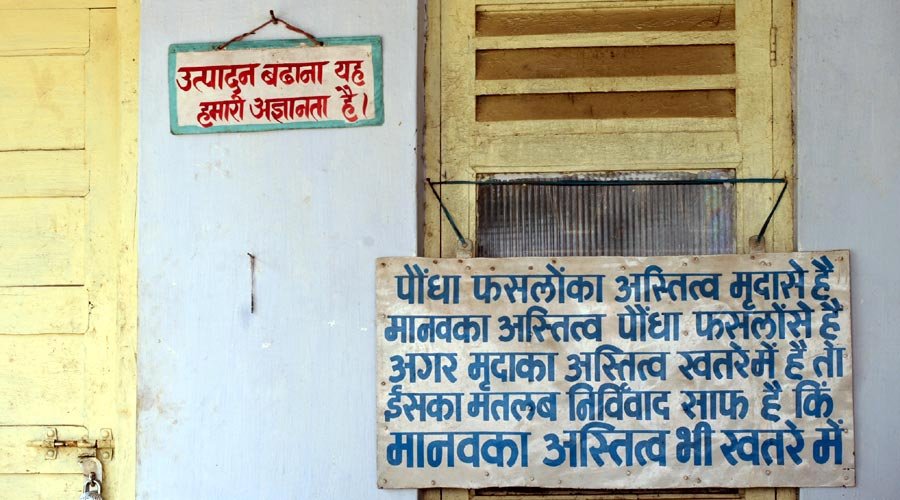
Agricultural Mis-education
This country has more than 150 agricultural universities, many with huge landholdings of thousands of acres. They have no dearth of infrastructure, equipment, staff, money… and yet, not one of these heavily subsidized universities makes any profit, or grows any significant amount of food, if only to feed its own staff and students. But every year, each churns out several hundred ‘educated’ unemployables, trained only in misguiding farmers and spreading ecological degradation.
In all the six years a student spends for an MSc in agriculture, the only goal is short-term – and narrowly perceived – ‘productivity’. For this, the farmer is urged to do and buy a hundred things. But not a thought is spared to what a farmer must never do so that the land remains unharmed for future generations and other creatures. It is time our people and government wake up to the realisation that this industry-driven way of farming – promoted by our institutions – is inherently criminal and suicidal!
Gandhi declared, “Where there is soshan, or exploitation, there can be no poshan, or nurture!” Vinoba Bhave added, “Science wedded to compassion can bring about a paradise on earth. But divorced from non-violence, it can only cause a massive conflagration that swallows us in its flames.”
Trying to increase Nature’s ‘productivity’ is the fundamental blunder that highlights the ignorance of ‘agricultural scientists’ like you. Nature, unspoiled by man, is already most generous in her yield. When a grain of rice can reproduce a thousand-fold within months, where arises the need to increase its productivity?
Numerous kinds of fruit trees too yield many thousand Kg of nourishment each in their lifetime! That is, provided the farmer does not pour poison and mess around the tree in his greed for quick profit. A child has a right to its mother’s milk. But if we draw on Mother Earth’s blood and flesh as well, how can we expect her continuing sustenance!
The mind set of servitude to ‘commerce and industry’, ignoring all else, is the root of the problem. But industry merely transforms ‘raw materials’ sourced from Nature into commodities. It cannot create anew. Only Nature is truly creative and self-regenerating – through synergy with the fresh daily inflow of the sun’s energy.

The Six Self-renewing Paribals of Nature
There is on earth a constant interplay of the six paribals (key factors) of Nature, interacting with sunlight. Three are – air, water and soil. Working in tandem with these, are the three orders of life -‘vanaspati srushti’ (the world of plants), ‘ jeev srushti’ (the realm of insects and micro-organisms), and ‘prani srushti’ (the animal kingdom). These six paribals maintain a dynamic balance. Together, they harmonise the grand symphony of Nature, weaving the new!
Man has no right to disrupt any of the paribals of Nature. But modern technology, wedded to commerce – rather than wisdom or compassion – has proved disastrous at all levels. We have despoiled and polluted the soil, water and air. We have wiped out most of our forests and killed its creatures; …and relentlessly, modern farmers spray deadly poisons on their fields.
These massacre Nature’s jeev srushti – the unpretentious but tireless little workers that maintain the ventilated quality of the soil, and recycle all life-ebbed biomass into nourishment for plants. The noxious chemicals also inevitably poison the water, and Nature’s prani srushti, which includes humans.
The Root of Unsustainability
Sustainability is a modern concern, scarcely talked of at the time you championed the ‘green revolution’. Can you deny that for more than forty (some say hundred) centuries, our ancestors farmed the natural organic way – without any marked decline in soil fertility, as in the past four or five decades? Is it not a stark fact that the chemical-intensive and irrigation-intensive way of growing monoculture cash-crops, has been primarily responsible for spreading ecological devastation far and wide in this country? Within the lifetime of a single generation!
Engineered Erosion of Crop Diversity, Scarcity of Organic Matter, and Soil Degradation
This country boasted an immense diversity of crops, adapted over millennia to local conditions and needs. Our numerous tall, indigenous varieties of grain provided more biomass, shaded the soil from the sun, and protected against its erosion under heavy monsoon rains. But in the guise of increasing crop production, exotic dwarf varieties were introduced and promoted through your efforts. This led to more vigorous growth of weeds, which were now able to compete successfully with the new stunted crops for sunlight. The farmer had to spend more labour and money in weeding, or spraying herbicides.
The straw growth with the dwarf grain crops fell drastically to one-third of that with most native species! In Punjab and Haryana, even this was burned, as it was said to harbour ‘pathogens’ (It was too toxic to feed farm cattle that were progressively displaced by tractors). Consequently, much less organic matter was locally available to recycle the fertility of the soil, leading to an artificial need for externally procured inputs. Inevitably, the farmers resorted to use more chemicals, and relentlessly, soil degradation and erosion set in.
Engineered Pestilence
The exotic varieties, grown with chemical ‘fertiliser’, were more susceptible to ‘pests and diseases’, leading to yet more poison (insecticides, etc.) being poured. But the attacked insect species developed resistance and reproduced prolifically. Their predators – spiders, frogs, etc. – that fed on these insects and ‘biologically controlled’ their population, were exterminated. So were many beneficial species like the earthworms and bees.
Agribusiness and technocrats recommended stronger doses, and newer, more toxic (and more expensive) chemicals. But the problems of ‘pests’ and ‘diseases’ only worsened. The spiral of ecological, financial and human costs mounted!
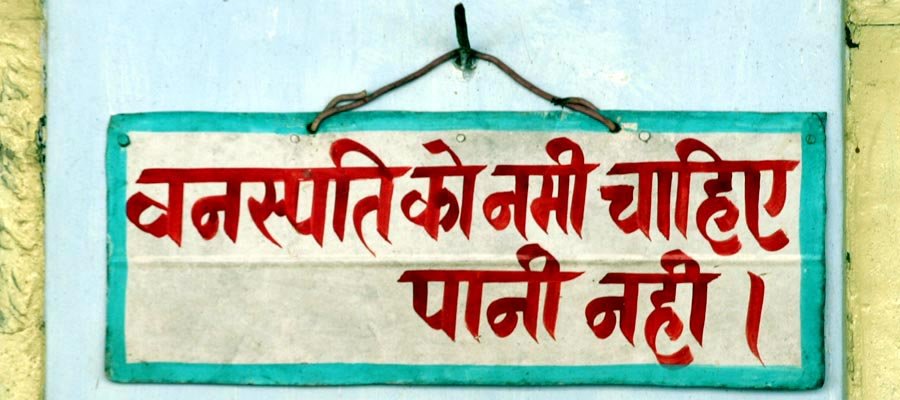
The ‘Development’ of Water Scarcity and Dead, Salty Soils
With the use of synthetic fertilizer and increased cash-cropping, irrigation needs rose enormously. In 1952, the Bhakra dam was built in Punjab, a water-rich state fed by five Himalayan rivers. Several thousand more big and medium dams followed all over the country, culminating in the massive Sardar Sarovar. And now, our government is toying with a grandiose, Rs. 560,000 crore proposal to divert and ‘inter-link’ the flow of our rivers. This is sheer ‘Tughlaqian’ megalomania, without a thought for future generations!
India, next to South America, receives the highest rainfall in the world. The annual average is almost 4 feet. Where thick vegetation covers the ground, and the soil is alive and porous, much of this rain is soaked and stored in the soil and sub-soil strata. A good amount then percolates deeper to recharge aquifers, or ‘groundwater tables’.
The living soil and its underlying aquifers thus serve as gigantic, ready-made reservoirs gifted free by Nature. Particularly efficient in soaking rain are the lands under forests and trees. Thus, half a century ago, most parts of India had enough fresh water all-round the year, long after the rains had stopped and gone. But clear the forests, and the capacity of the earth to soak the rain drops drastically. Streams and wells run dry. It has happened in too many places already.
While the recharge of groundwater has greatly reduced, its extraction has been mounting. India is presently mining over 20 times more groundwater each day than it did in 1950. Much of this is mindless wastage by a minority. But most of India’s people – living on hand-drawn or hand-pumped water in villages, and practising only rain-fed farming – continue to use the same amount of ground water per person, as they did generations ago.
More than 80% of India’s water consumption is for irrigation, with the largest share hogged by chemically cultivated cash crops. Maharashtra, for example, has the maximum number of big and medium dams in this country. But sugarcane alone, grown on barely 3-4% of its cultivable land, guzzles about 70% of its irrigation waters!
One acre of chemically grown sugarcane requires as much water as would suffice 25 acres of jowar, bajra, or maize. The sugar factories too consume huge quantities. From cultivation to processing, each kilo of refined sugar needs 2 to 3 tonnes of water. This could be used to grow, by the traditional, organic way, about 150 to 200 kg of nutritious jowar or bajra (native millets).
While rice is suitable for rain-fed farming, its extensive multiple cropping with irrigation in winter and summer as well, is similarly hogging our water resources, and depleting aquifers. As with sugarcane, it is also irreversibly ruining the land through salinisation.
Soil salinisation is the greatest scourge of irrigation-intensive agriculture, as a progressively thicker crust of salts is formed on the land. Many million hectares of cropland have been ruined by it. The most serious problems are caused where water-guzzling crops like sugarcane or basmati rice are grown round the year, abandoning the traditional mixed-cropping and rotation systems of the past, which required minimal or no watering.
Since at least 60% of the water used for irrigation nowadays in India, is excessive, indeed harmful, the first step that needs to be taken is to control this. Thus, not only will the grave damage caused by too much irrigation stop, but a good deal of the water that is saved can also become available locally for priority areas where acute scarcity is felt.
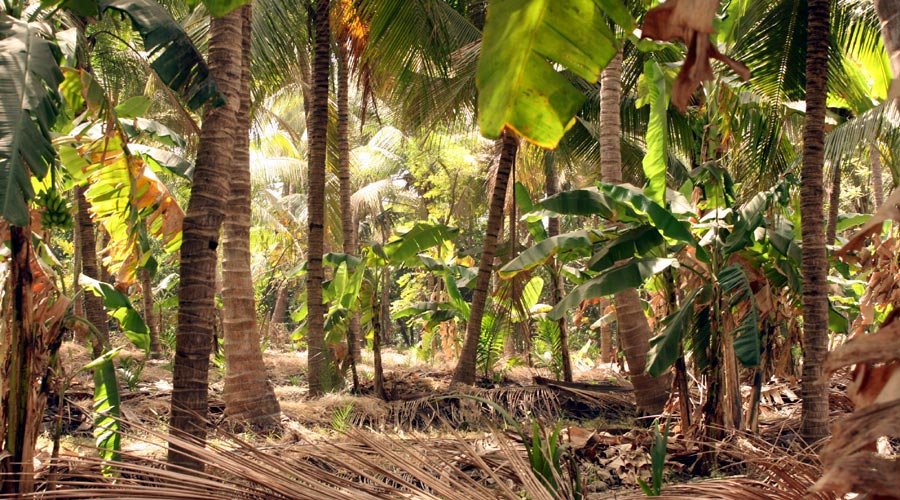
Conservative Irrigation and Groundwater Recharge at Kalpavruksha
Efficient, organic farming requires very little irrigation – much less than what is commonly used in modern agriculture. The yields of the crops are best when the soil is just damp. Rice is the only exception that grows even where water accumulates, and is thus preferred as a monsoon crop in low-lying areas naturally prone to inundation. Excess irrigation in the case of all other crops expels the air contained in the soil’s inter-particulate spaces – vitally needed for root respiration – and prolonged flooding causes root rot.
The irrigation on my farm is a small fraction of that provided in most modern farms today. Moreover, the porous soil under the thick vegetation of the orchard is like a sponge that soaks and percolates to the aquifer, or ground-water table, an enormous quantity of rain each monsoon. The amount of water thus stored in the ground at Kalpavruksha, is far more than the total amount withdrawn from the well for irrigation in the months when there is no rain.
Thus, my farm is a net supplier of water to the eco-system of the region, rather than a net consumer! Clearly, the way to ensure the water security and food security of this nation is by organically growing mixed, locally suitable crops, plants and trees, following the laws of Nature.
Need for 30% Tree Cover
We should restore at least 30% ground cover of mixed, indigenous trees and forests within the next decade or two. This is the core task of ecological water harvesting – the key to restoring the natural abundance of groundwater. Outstanding benefits can be achieved within a decade at comparatively little cost. We sadly fail to realise that the potential for natural water storage in the ground is many times greater than the combined capacity of all the major and medium irrigation projects in India – complete, incomplete, or still on paper! Such decentralized underground storage is more efficient, as it is protected from the high evaporation of surface storage. The planting of trees will also make available a variety of useful produce to enhance the well-being of a larger number of people.
Even barren wastelands can be restored to health in less than a decade. By inter-planting short life-span, medium life-span, and long life-span crops and trees, it is possible to have planned continuity of food yield to sustain a farmer through the transition period till the long-life fruit trees mature and yield. The higher availability of biomass and complete ground cover round the year will also hasten the regeneration of soil fertility.
Production, Poverty & Population
After the British left, Indian agriculture was recovering steadily. There was no scarcity of diverse nourishment in the countryside, where 75% of India lived. The actual reason for pushing the ‘Green Revolution’ was the much narrower goal of increasing marketable surplus of a few relatively less perishable cereals to fuel the urban-industrial expansion favoured by the government.
The new, parasitical way of farming you vigorously promoted, benefited only the industrialists, traders and the powers-that-be. The farmers’ costs rose massively and margins dipped. Combined with the eroding natural fertility of their land, they were left with little in their hands, if not mounting debts and dead soils. Many gave up farming. Many more want to do so, squeezed by the ever-rising costs. This is nothing less than tragic, since Nature has generously gifted us with all that is needed for organic farming – which also produces wholesome, rather than poisoned food!
Restoring the natural health of Indian agriculture is the path to solve the inter-related problems of poverty, unemployment and rising population. The maximum number of people can become self-reliant through farming only if the necessary inputs are a bare minimum. Thus, farming should require a minimum of financial capital and purchased inputs, minimum farming equipment (plough, tools, etc.), minimum necessary labour, and minimum external technology. Then, agricultural production will increase, without costs increasing. Poverty will decline, and the rise in population will be spontaneously checked.
Self-reliant farming – with minimal or zero external inputs – was the way we actually farmed, very successfully, in the past. Barring periods of war and excessive colonial oppression, our farmers were largely self-sufficient, and even produced surpluses, though generally smaller quantities of many more items. These, particularly perishables, were tougher to supply urban markets. And so the nation’s farmers were steered to grow chemically cultivated monocultures of a few cash-crops like wheat, rice, or sugar, rather than their traditional polycultures that needed no purchased inputs.
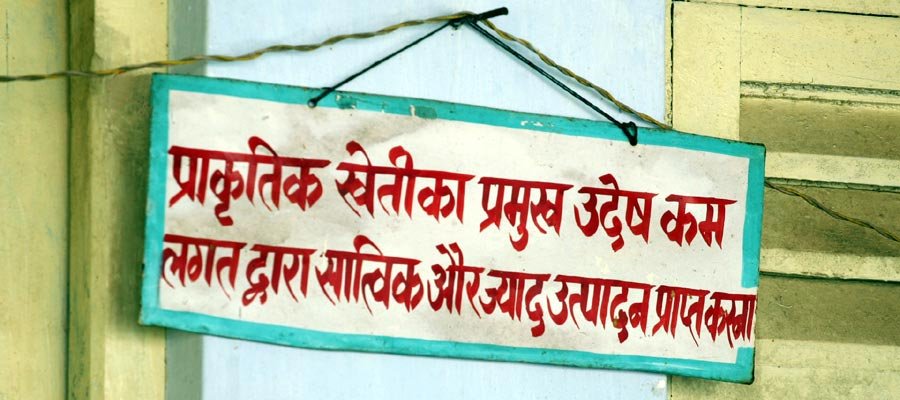
In Conclusion
I hope you have the integrity to support widespread change to mixed organic farming, tree-planting and forest regeneration (with local resources and rights) – that India greatly needs. I would be glad to answer any query or doubt posed to me, preferably in writing. I also welcome you to visit my farm with reasonable prior notice. Since many years, I have extended an open invitation to anyone interested in natural/organic farming to visit Kalpavruksha, on any Saturday afternoon between 2.00 and 4.00 pm, which continues till date.
I may finally add that this letter has been transcribed in English by Bharat Mansata, based on discussions with me in Gujarati.
Whether or not you agree with my views, I look forward to your reply.
Yours sincerely,
Bhaskar H. Save
The first open letter had few annexures. One such annexure published as a separate article, outlines 18 differences between chemical and organic farming. This letter was followed by two more open letters, the highlights from which are shared in the article – From green to evergreen revolution.
To know more about Bhaskar-ji’s ways of farming and his worldview, one should read ‘The vision of Natural Farming’ written by Bharat Mansata and published by Earthcare Books.















Thanks for this post. Will u be publishing the other 2 letters?
I want to understand more about the post independence scenario and the ‘food shortage’ or ‘ship to mouth existence’ we read about which necessitated green revolution. How true is that? Was it only about wheat and rice shortage, and other food (millets, vegetables, fruits) were available in abundance? There waa no nutirtional deficiency and food was available in abundance even during/after British rule? Data about this would be good. Increased production through new varieties, irrigation and chemicals was absolutely not needed?
would be publishing an annexure but unsure about the other two letters. if needed, i will publish them here
I was already contemplating surrendering my BSc Ag. This article just augments that desire. Not just agriculture colleges, even majority of BSchools are producing unemployable grads with zero business aptitude and experience. O
Its true that none of the agriculture grads practice agriculture and end up as agri input salesmen. How to ensure that education delivers what it is meant to?
pantnagar university has played a special role in killing the rain-fed agricultural practice of uttarakhand.
regarding other queries, i think mono cultural agri-practices were designed to feed the centralized industrial economy. when we talk of scarcity, even today a huge amount of food is wasted because it is ‘ugly’. lesser variety of food is making things complex. like in most other professions, the middlemen are making more money. there is no one single answer to these questions. just think about a scenario – we majorly replace wheat with madua. won’t our net requirements, it terms of volume, go down? i cross checked with many coconut growers, found no one having a better yield than bhaskar saveji’s farm. pantnagar and viveknanda institute have, after decades of existence, not even able to figure out the difference between ‘upraon’ and ‘talaon’ seeds. such is the sad state of affairs!
btw, a UK study reveals 40% wastage of food because its ugly. i do not think anyone undertook such study in india. but non-localised agro-economy must be leading to significant amount of waste
That is rather a lengthy but very necessary letter, I suspect. As it was penned almost half a decade ago, I wondered if there have been any developments in India’s agricultural policy. Hopefully!. It’s very sad to read but it made me happy to learn some words and terms in another language.